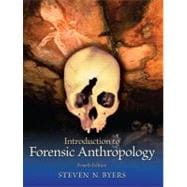
Note: Supplemental materials are not guaranteed with Rental or Used book purchases.
Purchase Benefits
What is included with this book?
Steve Byers received his B.A. and M.A. from Colorado State University in Ft. Collins, CO. His Master’s Thesis, entitled “A reconstruction of the skull of Gigantopithecus blacki”, formed the basis for YFX Studio's full reconstruction of Gigantopithecus on display at the San Diego Museum of Man. His first teaching job was at the University of Southern Colorado (now call Colorado State Universiy, Pueblo) where he taught Anthropology for two and a half years. From there, he worked as a social and psychological researcher until he decided that his true love was Anthropology. He enrolled at the University of New Mexico (UNM) in Albuquerque, NM, where he studied skeletal biology and bioarchaeology.
Since graduating in 1992, he has taught part-time at the various campuses of UNM as well as Santa Fe Community College. When given the opportunity to teach a forensic anthropology class at UNM in 1998, he realized that the field lacked a comprehensive textbook. Since no one appeared to be writing one, he decided to take on the project. The first edition of his textbook, published by Allyn and Bacon (since subsumed under Prentice Hall), appeared in 2002, and has been put into new editions three times. The book received a very favorable review in the Journal of Forensic Sciences, as well as several regional anthropology associations.
1. Introduction.
Historical Background.
Forensic Anthropologists and the Medicolegal Community.
The Forensic Anthropology Protocol and
Methods in Forensic Anthropology.
2. Basics of Human Osteology and Odontology.
Overview of the Human Skeleton.
Basic Topics in Osteology.
Overview of the Human Dentition.
3. Establishing the Forensic Context.
Bone versus Non-Bone.
Human versus Non-Human.
Contemporary versus Non-Contemporary.
4. Recovery Scene Methods.
Preliminary Issues.
Locating Remains.
Mapping Remains.
Grave Excavation.
Collecting Remains.
Mass Disasters.
DMORT.
5. Estimating Time Since Death.
Overview of Decomposition.
Decomposition and Skeletonization.
Animal Scavenging.
Other Methods.
6. Initial Treatment and Examination.
Forensic Anthropology Laboratory.
Preparation of Remains.
Reconstruction, Sorting, and Re-Assembly.
Inventorying Remains.
7. Attribution of Ancestry.
Anthroposcopic Traits.
Metrical Methods.
Miscellaneous Ancestral Characteristics.
8. Attribution of Sex.
Sexing the Pelvis.
Sexing the Skull.
Miscellaneous Methods.
Sexing Subadults.
9. Estimation of Age at Death.
Subadults.
Adults.
10. Calculation of Stature.
Basics of Stature Reconstruction.
Full Skeleton Methods.
Long Limb Bones.
Other Skeletal Elements.
Partial Long Limb Bones.
Adjustments to Stature.
11. Death, Trauma, and the Skeleton.
Cause and Manner of Death.
Basics of Bone Trauma.
Characteristics of Forces Causing Trauma.
Types of Trauma.
Timing of Bone Injury.
12. Projectile Trauma.
Basics of Ammunition and Firearms.
Effects of Bullets on Bone.
Bullet Wound Analysis.
Pellet Wound Analysis.
Miscellaneous Projectiles.
Cause and Manner of Death.
13. Blunt Trauma.
Characteristics of Instruments.
Types of Fractures.
Effects of Blunt Instruments.
Wound Analysis.
Cause and Manner of Death.
14. Sharp and Miscellaneous Trauma.
Sharp Trauma.
Strangulation.
Chemical Trauma.
Cause and Manner of Death.
15. Antemortem Skeletal Conditions.
Pathological Conditions.
Skeletal Anomalies.
Occupational Stress Markers.
16. Postmortem Changes to Bone.
Dismemberments.
Animal Scavenging.
Fire Damage.
Weathering.
Burial Damage.
Water Transport Damage.
Miscellaneous.
17. Additional Aspects of Individualization.
Facial Reproduction.
Assessing Handedness.
Estimating Body Weight.
18. Identification Using Antemortem Records.
Radiography.
Photographic Superimposition.
Forensic Odontology.
Miscellaneous.
19. Conclusion.
Ethical Responsibilities.
The Final Report.
Courtroom Testimony.
Future of Forensic Anthropology.
Short Retail Description
The New copy of this book will include any supplemental materials advertised. Please check the title of the book to determine if it should include any access cards, study guides, lab manuals, CDs, etc.
The Used, Rental and eBook copies of this book are not guaranteed to include any supplemental materials. Typically, only the book itself is included. This is true even if the title states it includes any access cards, study guides, lab manuals, CDs, etc.